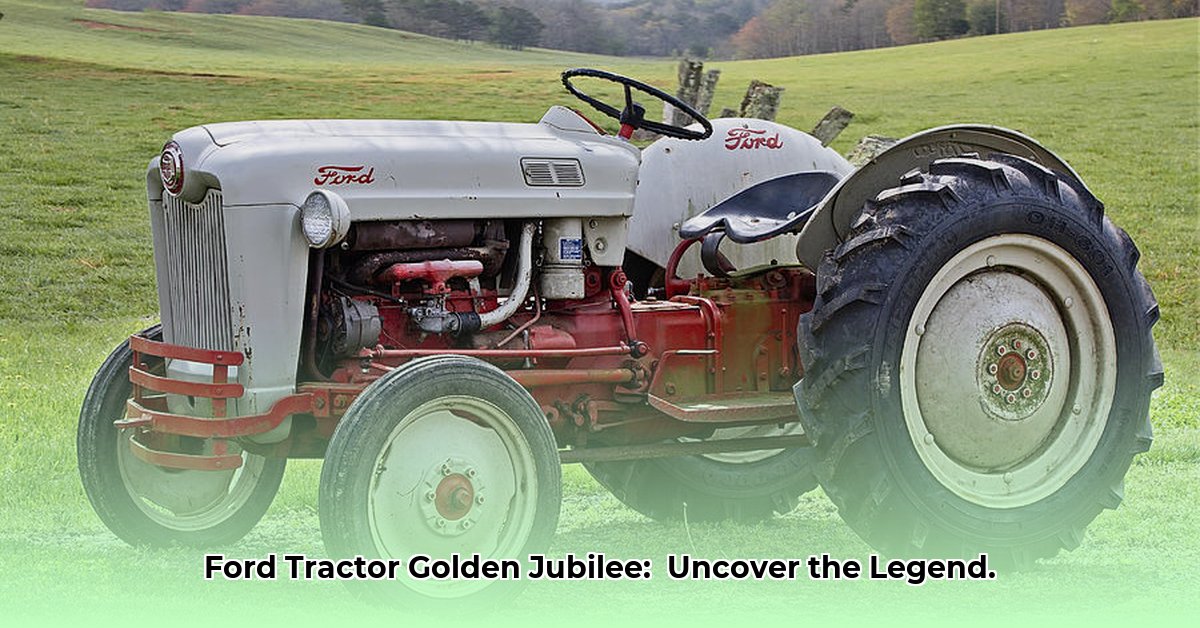
The Ford NAA Golden Jubilee tractor: a name that evokes images of rolling fields, the scent of freshly turned earth, and the steady rumble of a powerful engine. More than just a piece of farm machinery, this iconic tractor represents a pivotal moment in post-war American agriculture. This guide explores its history, its technical specifications, the joys (and challenges) of restoration, and how to find your own piece of this enduring legacy. For helpful painting tips, check out this resource: Ford Tractor Paint.
The Golden Jubilee's Enduring Legacy
Produced between 1953 and 1954, a remarkable 128,965 Ford NAA Golden Jubilee tractors rolled off the assembly line. This wasn't just a manufacturing milestone; it signified a significant technological leap forward for American farmers. Post-war agriculture craved efficient machinery, and the NAA delivered. Its enduring popularity among collectors highlights its importance as a powerful symbol of a transforming agricultural landscape. This tractor isn't simply a collection of steel and gears; it embodies the innovative spirit and tireless efforts of a generation that shaped American food production. Why did this tractor resonate so deeply with farmers of the time? It represented a crucial step towards modernization.
Under the Hood: A Closer Look at the NAA
The NAA’s heart beats with a 2.2-liter gasoline engine. While its 20 horsepower at the drawbar (the pulling power) and 30 horsepower at the PTO (power take-off) seem modest by modern standards, consider this: in its day, it was a game-changer. This power, combined with its 11-gallon fuel tank and smooth four-speed transmission, allowed farmers to work longer hours with less downtime. This meant increased efficiency and productivity—a significant improvement during a period of rapid agricultural expansion. Is it any wonder this tractor became so beloved?
Finding Your Golden Ticket: The Collector's Journey
Tracking down a Golden Jubilee demands patience and persistence. Explore online forums dedicated to classic tractors, attend antique tractor shows, and keep an eye out for those elusive "For Sale" signs. Word-of-mouth recommendations from within the collector community can also yield promising leads. However, caution is advised. Before purchasing, conduct a thorough inspection. Check the engine compression, test the transmission's shifting, and inspect the entire chassis for structural issues. Multiple detailed photographs from various angles are essential, and seeking a second opinion from a seasoned mechanic specializing in vintage tractors is a wise investment. What's the biggest risk a prospective buyer faces? Purchasing a tractor that requires extensive and costly repairs.
The Rewarding Challenge of Restoration
Restoring a Golden Jubilee is a labor of love, a fascinating blend of mechanical skill and historical preservation. Sourcing original parts can be challenging, requiring resourcefulness and a strong network within the collector community. Online forums dedicated to vintage tractors offer invaluable support and connections to parts suppliers. But the reward is immense. A meticulously restored NAA Golden Jubilee becomes a source of immense pride—a testament to the dedication and craftsmanship invested in revitalizing a piece of agricultural history. What’s the most rewarding aspect of the restoration process? The tangible connection to history.
Beyond the Fields: The NAA's Historical Significance
The Ford NAA Golden Jubilee wasn't merely a machine; it was a symbol of post-war optimism and a crucial transition in agricultural technology. Its open operator station, characteristic of tractors from that era, lacked the safety features found in modern equipment. Its gasoline engine reflected the prevalent technology of the time. Yet, its simplicity and effectiveness resonated with farmers, representing a blend of practicality and innovation. The NAA stands as a tangible link to a bygone era, illustrating the hard work and ingenuity of those who fed the nation. What makes the NAA truly exceptional? Its embodiment of post-war American optimism.
Preserving Your Investment: Value and Care
The value of a meticulously restored NAA Golden Jubilee can fluctuate significantly based on its condition, the originality of its parts, and the availability of supporting documentation. Well-maintained tractors command higher prices among collectors. Proper storage, preventative maintenance, and a carefully executed restoration process significantly safeguard your investment and ensure this piece of history endures for future generations. What influences the value of a restored Golden Jubilee? Condition and originality are key factors.
Your Action Plan: Steps to Golden Jubilee Ownership
- Thorough Research: Begin with comprehensive online and in-person research to understand the tractor's market value and condition.
- Expert Consultation: Seek advice from knowledgeable individuals within the collector community to assess the tractor's condition and potential.
- Networking: Engage with online forums and clubs to connect with other enthusiasts and access invaluable resources and support.
- Meticulous Documentation: Maintain a detailed record of the restoration process, including photographs and parts lists.
- Patient Restoration: Embrace the process as a rewarding journey, not simply a short-term project.
Weighing the Pros and Cons: Is a Golden Jubilee Right for You?
| Pros | Cons |
|---|---|
| Rich history and heritage | Parts sourcing can be challenging |
| Potential for value appreciation | Restoration is time-consuming and costly |
| Satisfying restoration project | Requires mechanical aptitude or professional help |
| Connects you to agricultural history | May require specialized tools and workspace |
| Sense of accomplishment | It’s a long-term commitment |
The Ford NAA Golden Jubilee is more than just a tractor; it's an emblem of American ingenuity and the agricultural heritage of our nation. For the dedicated collector, it’s a rewarding journey into the past, a connection to a bygone era, and a tangible link to the individuals and machines that shaped our world.